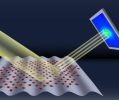UK and Siberian scientists develop spectroscopy solution for phony clothing
 British and Russian scientists have developed new terahertz spectroscopy technology, a potential barrier to prevent counterfeit clothing from hitting consumer markets.
British and Russian scientists have developed new terahertz spectroscopy technology, a potential barrier to prevent counterfeit clothing from hitting consumer markets.British and Russian scientists have developed new terahertz spectroscopy technology, a potential barrier to prevent counterfeit items of clothing from hitting consumer markets, The Engineer reported earlier this month. This is said to be the result of a joint endeavor between the UK?s National Physical Laboratory (NPL) and the Institute of Monitoring of Climatic and Ecological Systems in Tomsk, in Russia?s Siberia. The new technique, based on terahertz time-domain spectroscopy, is expected to help customs officers ascertain whether items of clothing are fake, thus assisting them in the seizure and destruction of fake goods. This technique is assumed to require the generation of a beam of terahertz radiation, which is a band of electromagnetic radiation that falls between microwaves and infrared light. A sample of fabric is then placed within this beam, and the properties of the terahertz waves are detected after passing through the fabric. The composition and structure of the different types of fabric give rise to different rates of beam scattering and absorption, the source underscored. Different fabrics possess a distinct transmission profile, which gives it what the scientists refer to as ?signature? indicating whether or not the fabric in question is counterfeit...
Похожее
Siberian scientists develop new material for surveying systems and diagnostics
Siberian researchers offer technology to upgrade LEDs
RFID tagging underpants and slippers?
Novosibirsk researchers develop material for brand new infrared sights
Siberian scientists develop nanodrugs to fight cancer; regulators give green light
TSU Scientists have found an investor for X-ray units serialization